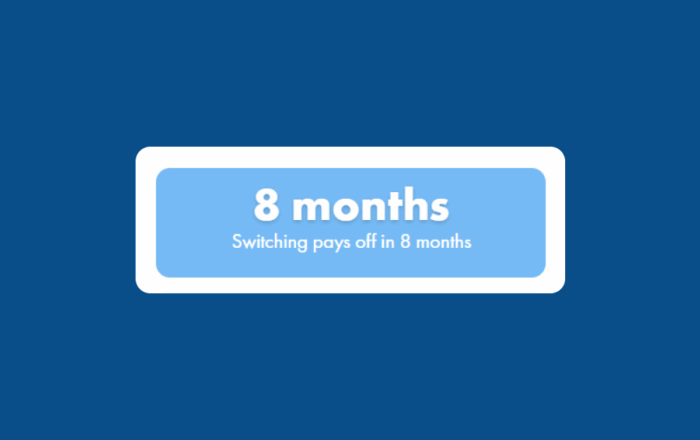Air Conditioner Upgrade Energy Savings Calculator
2 minute readHow much can you save with a more energy efficient air conditioner?
Home > BKV Energy Blog > All Posts > How Much Power Does a Microwave Use?
4 minute read • Last update February 2025

As an essential kitchen appliance, microwave ovens are the unsung heroes of many households, making it easy to defrost frozen meals, reheat leftovers, and more. But have you ever wondered how much power a microwave uses and how it impacts your electric bill?
In this quick guide, we’ll discuss typical microwave wattage, power consumption, and ways to save money on your monthly electric bill by improving your appliance’s energy efficiency.
That depends on the microwave in question. For example, commercial microwave ovens use more power than the smaller microwaves you’ll find in most homes. And, even with a standard microwave, energy consumption varies as a higher-wattage microwave will consume more electricity than lower-wattage models. Plus, total energy usage differs significantly between households. However, even though frequent microwave use can add up on your utility bill over time, the average microwave doesn’t use as much electrical energy as larger appliances like ranges and dishwashers.
The wattage of a microwave varies based on size and heating capacity. Here’s a generalized breakdown of average microwave wattage:
As with other appliances, microwave usage is measured in kilowatt-hours (kWh) of electricity. To calculate total electricity usage and convert that to a dollar amount for monthly and yearly costs, you’ll need to run a quick calculation—which we’ll cover in the following sections. But, if you’d prefer to avoid the math, a good ballpark based on normal microwave wattage is around $0.20 per hour.
The average wattage of a microwave is 800-1000. However, some models go as low as 600 and as high as 1700. If you’re unsure, you can determine the input wattage of your appliance using one of the following methods:
Once you know how much energy your microwave uses, estimating the overall effect on your electricity bills is easier.
Before we answer that definitively, let’s recap what we’ve learned and review a few frequently asked questions about microwave power consumption and cooking power:
That’s the basics covered. But, how much power does a microwave use every week, month, or year in your in your home, specifically? Let’s examine annual microwave electricity flows in more detail to find out.
It’s easier to calculate weekly total energy figures first, then multiply by 52 to get your yearly costs. Here’s how it’s done.
To calculate how many kWh of electricity you use, multiply the relevant wattage for microwave use by the number of hours you use it, and divide by 1,000. Let’s say you use your 1000-watt microwave for around 2 hours per week. The calculation would be: 2000 ÷ 1,000 = 2 kWh.
To turn kWh into a dollar amount, simply multiply the total by the rate shown in the energy usage breakdown section of the monthly bill you receive from your utility provider. The average electricity rate in Texas is $0.15 per kWh. So, 2 kWh would equal around $0.30 per week, with an estimated yearly cost of $15.60.
Here’s a quick reference table to help you estimate yearly costs based on a 15c per kWh electricity rate.
| Microwave Wattage | Hours per Week | Hours per Year | Annual Cost |
|---|---|---|---|
| 600 | 1 | 52 | $4.68 |
| 1.5 | 78 | $7.02 | |
| 2 | 104 | $9.36 | |
| 2.5 | 130 | $11.7 | |
| 3 | 156 | $14.04 | |
| 700 | 1 | 52 | $5.46 |
| 1.5 | 78 | $8.19 | |
| 2 | 104 | $10.92 | |
| 2.5 | 130 | $13.65 | |
| 3 | 156 | $16.38 | |
| 800 | 1 | 52 | $6.24 |
| 1.5 | 78 | $9.36 | |
| 2 | 104 | $12.48 | |
| 2.5 | 130 | $15.6 | |
| 3 | 156 | $18.72 | |
| 900 | 1 | 52 | $7.02 |
| 1.5 | 78 | $10.53 | |
| 2 | 104 | $14.04 | |
| 2.5 | 130 | $17.55 | |
| 3 | 156 | $21.06 | |
| 1000 | 1 | 52 | $7.8 |
| 1.5 | 78 | $11.7 | |
| 2 | 104 | $15.6 | |
| 2.5 | 130 | $19.5 | |
| 3 | 156 | $23.4 | |
| 1100 | 1 | 52 | $8.58 |
| 1.5 | 78 | $12.87 | |
| 2 | 104 | $17.16 | |
| 2.5 | 130 | $21.45 | |
| 3 | 156 | $25.74 | |
| 1200 | 1 | 52 | $9.36 |
| 1.5 | 78 | $14.04 | |
| 2 | 104 | $18.72 | |
| 2.5 | 130 | $23.4 | |
| 3 | 156 | $28.08 |
Of course, these estimations only apply if you’re buying energy from the grid rather than using a solar generator. If your home is fitted with solar panels, even running a higher-wattage model could cost you nothing!
If you’re in the market for a new microwave oven, look for these energy-saving features to maximize efficiency:
These handy features will help you increase efficiency—even on powerful microwaves–without sacrificing convenience, cooking performance, or taste.
If you’re not quite ready for a new microwave just yet, there are still some practical ways you can save money on your electric bill by reducing power consumption. Here are a few top tips and best practices:
Implementing these tips will help you cut down on unnecessary energy use, lower your electricity costs, and extend the lifespan of your microwave.
Understanding how much power your microwave uses is a good step toward smarter electricity consumption. But why stop there? If you’re looking to make even bigger savings, switching to a more cost-effective energy plan could help save money—without changing your daily habits.
At BKVE, we believe you deserve a transparent, gimmick-free electricity plan that fits your household’s unique energy needs. Check out our popular Bluebonnet plan today, or enter your zip code to compare rates and find the best plan for your family.
Graham Lumley, Digital Marketing Manager at BKV Energy, leads digital and traditional marketing strategies, focusing on educating Texans about the state's deregulated energy market. With over 8 years of marketing experience, he creates content to help consumers understand and save on their energy bills, bringing a fresh and dynamic approach to the industry.

How much can you save with a more energy efficient air conditioner?

Is it worth to pay the Early Termination Fee to switch electricity plans?
Get $50 off your electric bill!
Use code BKVEJOINUS50
Enter your zip code to shop BKV Energy's affordable, fixed-rate Texas electricity plans. Use the promo code for $50 off your electric bill.